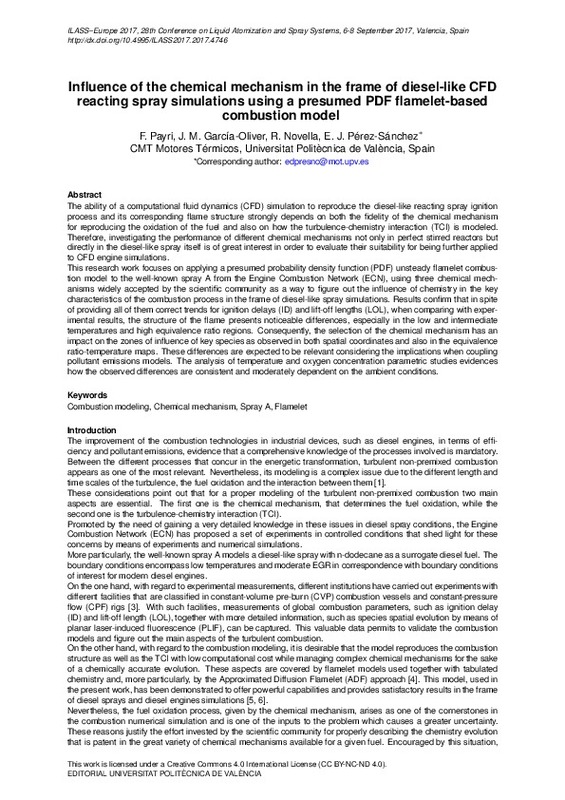JavaScript is disabled for your browser. Some features of this site may not work without it.
Buscar en RiuNet
Listar
Mi cuenta
Estadísticas
Ayuda RiuNet
Admin. UPV
Influence of the chemical mechanism in the frame of diesel-like CFD reacting spray simulations using a presumed PDF flamelet-based combustion model
Mostrar el registro sencillo del ítem
Ficheros en el ítem
| dc.contributor.author | Payri González, Francisco
|
es_ES |
| dc.contributor.author | García Oliver, José María
|
es_ES |
| dc.contributor.author | Novella Rosa, Ricardo
|
es_ES |
| dc.contributor.author | Pérez Sánchez, Eduardo Javier
|
es_ES |
| dc.date.accessioned | 2018-05-09T10:11:17Z | |
| dc.date.available | 2018-05-09T10:11:17Z | |
| dc.date.issued | 2017-07-28 | |
| dc.identifier.isbn | 9788490485804 | |
| dc.identifier.uri | http://hdl.handle.net/10251/101599 | |
| dc.description.abstract | [EN] The ability of a computational fluid dynamics (CFD) simulation to reproduce the diesel-like reacting spray ignition process and its corresponding flame structure strongly depends on both the fidelity of the chemical mechanism for reproducing the oxidation of the fuel and also on how the turbulence-chemistry interaction (TCI) is modeled. Therefore, investigating the performance of different chemical mechanisms not only in perfect stirred reactors but directly in the diesel-like spray itself is of great interest in order to evaluate their suitability for being further applied to CFD engine simulations. This research work focuses on applying a presumed probability density function (PDF) unsteady flamelet combustion model to the well-known spray A from the Engine Combustion Network (ECN), using three chemical mechanisms widely accepted by the scientific community as a way to figure out the influence of chemistry in the key characteristics of the combustion process in the frame of diesel-like spray simulations. Results confirm that in spite of providing all of them correct trends for ignition delays (ID) and lift-off lengths (LOL), when comparing with experimental results, the structure of the flame presents noticeable differences, especially in the low and intermediate temperatures and high equivalence ratio regions. Consequently, the selection of the chemical mechanism has an impact on the zones of influence of key species as observed in both spatial coordinates and also in the equivalence ratio-temperature maps. These differences are expected to be relevant considering the implications when coupling pollutant emissions models. The analysis of temperature and oxygen concentration parametric studies evidences how the observed differences are consistent and moderately dependent on the ambient conditions. | es_ES |
| dc.description.sponsorship | Authors acknowledge that this work was possible thanks to the Ayuda para la Formación de Profesorado Universitario (FPU 14/03278) belonging to the Subprogramas de Formación y de Movilidad del Ministerio de Educación, Cultura y Deporte from Spain. Also this study was partially funded by the Ministerio de Economía y Competitividad from Spain in the frame of the COMEFF (TRA2014-59483-R) national project. | es_ES |
| dc.format.extent | 8 | es_ES |
| dc.language | Inglés | es_ES |
| dc.publisher | Editorial Universitat Politècnica de València | es_ES |
| dc.relation.ispartof | Ilass Europe. 28th european conference on Liquid Atomization and Spray Systems | es_ES |
| dc.rights | Reconocimiento - No comercial - Sin obra derivada (by-nc-nd) | es_ES |
| dc.subject | Combustion modeling | es_ES |
| dc.subject | Chemical mechanism | es_ES |
| dc.subject | Spray A | es_ES |
| dc.subject | Flamelet | es_ES |
| dc.title | Influence of the chemical mechanism in the frame of diesel-like CFD reacting spray simulations using a presumed PDF flamelet-based combustion model | es_ES |
| dc.type | Capítulo de libro | es_ES |
| dc.type | Comunicación en congreso | es_ES |
| dc.identifier.doi | 10.4995/ILASS2017.2017.4746 | |
| dc.relation.projectID | info:eu-repo/grantAgreement/MECD//FPU14%2F03278/ES/FPU14%2F03278/ | es_ES |
| dc.relation.projectID | info:eu-repo/grantAgreement/MINECO//TRA2014-59483-R/ES/MODELOS AVANZADOS DE COMBUSTION EN SPRAYS PARA PLANTAS PROPULSIVAS EFICIENTES/ | es_ES |
| dc.rights.accessRights | Abierto | es_ES |
| dc.contributor.affiliation | Universitat Politècnica de València. Escuela Técnica Superior de Ingeniería del Diseño - Escola Tècnica Superior d'Enginyeria del Disseny | es_ES |
| dc.contributor.affiliation | Universitat Politècnica de València. Instituto Universitario CMT-Motores Térmicos - Institut Universitari CMT-Motors Tèrmics | es_ES |
| dc.contributor.affiliation | Universitat Politècnica de València. Departamento de Máquinas y Motores Térmicos - Departament de Màquines i Motors Tèrmics | es_ES |
| dc.description.bibliographicCitation | Payri González, F.; García Oliver, JM.; Novella Rosa, R.; Pérez Sánchez, EJ. (2017). Influence of the chemical mechanism in the frame of diesel-like CFD reacting spray simulations using a presumed PDF flamelet-based combustion model. En Ilass Europe. 28th european conference on Liquid Atomization and Spray Systems. Editorial Universitat Politècnica de València. 678-685. https://doi.org/10.4995/ILASS2017.2017.4746 | es_ES |
| dc.description.accrualMethod | OCS | es_ES |
| dc.relation.conferencename | ILASS2017 - 28th European Conference on Liquid Atomization and Spray Systems | es_ES |
| dc.relation.conferencedate | September 06-08,2017 | es_ES |
| dc.relation.conferenceplace | Valencia, Spain | es_ES |
| dc.relation.publisherversion | http://ocs.editorial.upv.es/index.php/ILASS/ILASS2017/paper/view/4746 | es_ES |
| dc.description.upvformatpinicio | 678 | es_ES |
| dc.description.upvformatpfin | 685 | es_ES |
| dc.type.version | info:eu-repo/semantics/publishedVersion | es_ES |
| dc.relation.pasarela | OCS\4746 | es_ES |
| dc.contributor.funder | Ministerio de Educación, Cultura y Deporte | es_ES |
| dc.contributor.funder | Ministerio de Economía y Competitividad | es_ES |








